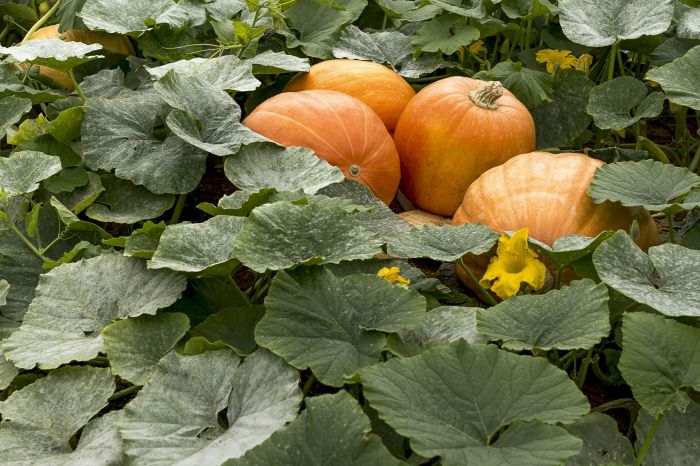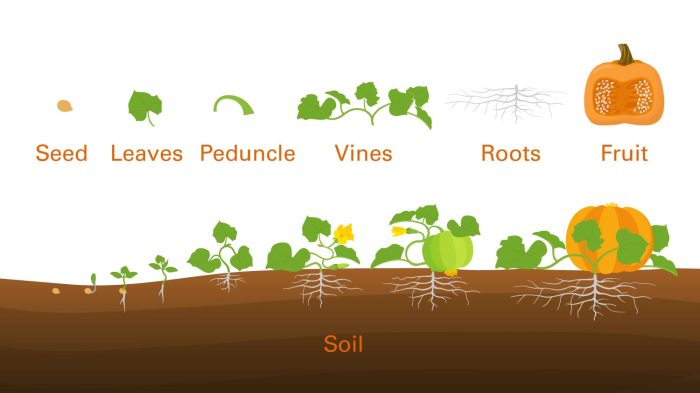Choosing the Right Pumpkin Seeds
How do you plant a pumpkin seed – Selecting the appropriate pumpkin seeds is crucial for a successful harvest. The variety chosen will significantly impact the size, shape, and flavor of the resulting pumpkin, as well as the plant’s overall growth habit. Careful consideration of seed quality and viability is also essential for maximizing germination rates and minimizing plant failure.
Pumpkin Seed Varieties
Several pumpkin varieties are suitable for home cultivation, each exhibiting unique characteristics. Choosing a variety depends on factors such as available space, desired pumpkin size, and personal preferences regarding taste and appearance. For example, ‘Connecticut Field’ pumpkins are known for their large size and traditional orange color, often exceeding 100 pounds. These are vigorous growers requiring ample space.
Conversely, ‘Jack Be Little’ pumpkins are compact, producing small, ornamental pumpkins ideal for smaller gardens. Their growth habit is more contained, making them suitable for containers or limited spaces. ‘Howden Biggie’ pumpkins, another large variety, are renowned for their exceptional sweetness and are well-suited for pie making. Their growth habit mirrors that of ‘Connecticut Field,’ demanding considerable space.
Finally, miniature pumpkins like ‘Baby Boo’ offer a decorative option, producing small, white pumpkins that are ideal for autumn displays. Their compact growth makes them easily manageable in various settings.
Selecting High-Quality Pumpkin Seeds, How do you plant a pumpkin seed
The appearance and source of pumpkin seeds are critical indicators of their quality and viability. High-quality seeds are typically plump, firm, and free from blemishes or discoloration. Avoid seeds that are shriveled, cracked, or exhibit signs of mold or insect damage. Purchasing seeds from reputable seed companies or nurseries ensures higher germination rates and a greater likelihood of success.
Seeds obtained from pumpkins grown in your own garden can also be used, provided they are harvested from healthy, mature pumpkins. It is crucial to thoroughly clean and dry these seeds before storage to prevent fungal growth and ensure optimal viability.
Testing Seed Germination Rates
Assessing seed viability before planting allows for accurate planning and helps prevent wasted effort. A simple germination test can be performed by placing a sample of seeds between moist paper towels in a sealed container. After several days, the number of seeds that have sprouted can be counted to determine the germination rate. A high germination rate (above 80%) indicates high seed quality.
For example, if 10 seeds are tested and 8 sprout, the germination rate is 80%. This information helps estimate the number of seeds needed to achieve the desired number of plants, accounting for potential germination failures. This method provides a reliable assessment of seed viability, enabling gardeners to make informed planting decisions and maximize their chances of a successful harvest.
Preparing the Planting Environment

Successful pumpkin cultivation hinges on establishing a suitable planting environment. This involves preparing the soil to provide optimal conditions for seed germination and plant growth, and ensuring adequate sunlight exposure. Careful consideration of these factors significantly impacts the yield and overall health of the pumpkin plants.
Soil Preparation for Pumpkin Seeds
Preparing the soil is a crucial step in pumpkin cultivation. Pumpkins thrive in well-drained, fertile soil with a slightly acidic to neutral pH (6.0-7.0). Before planting, conduct a soil test to determine its existing pH and nutrient levels. Soil testing kits are readily available from garden centers or online retailers. The results will guide the necessary soil amendments.
If the soil is too acidic, add lime to raise the pH. Conversely, if the soil is too alkaline, add sulfur to lower the pH. Amendments should be incorporated into the soil several weeks before planting to allow sufficient time for them to integrate. Furthermore, enriching the soil with organic matter, such as compost or well-rotted manure, improves drainage, aeration, and nutrient content.
Planting pumpkin seeds involves selecting healthy seeds, planting them about an inch deep in well-drained soil, and ensuring adequate sunlight. Similar principles apply to other seeds; for instance, understanding the germination process is crucial, much like learning how to successfully cultivate a plant from an avocado seed, as detailed in this helpful guide: plant from avocado seed.
Once established, pumpkin plants require regular watering and fertilization to produce a bountiful harvest.
This organic matter also helps retain moisture, crucial for young pumpkin seedlings. The soil should be tilled to a depth of at least 12 inches to ensure proper root development. Remove any rocks, weeds, or debris that might hinder growth. Finally, rake the soil to create a smooth, level surface suitable for planting.
Sunlight Requirements for Pumpkin Plants
Pumpkins are sun-loving plants requiring at least six to eight hours of direct sunlight daily. Insufficient sunlight leads to weak, spindly growth, reduced flowering, and smaller fruit. Conversely, excessive sunlight can scorch the leaves and stress the plants. Therefore, choose a planting location with ample sunlight exposure, preferably a south-facing area in the northern hemisphere or a north-facing area in the southern hemisphere.
Consider the surrounding landscape; tall trees or buildings can cast shade and reduce the amount of sunlight reaching the pumpkin plants. Planting in an open, sunny area ensures optimal growth and a bountiful harvest.
Comparison of Planting Methods
The choice between direct sowing and starting seeds indoors depends on various factors, including climate and the desired planting timeline.
| Planting Method | Advantages | Disadvantages | Considerations |
|---|---|---|---|
| Direct Sowing | Less labor-intensive; avoids transplanting shock; seeds adapt directly to outdoor conditions. | Slower germination; susceptible to pests and diseases; may require more frequent watering. | Suitable for warmer climates with longer growing seasons; requires careful seed placement and soil preparation. |
| Starting Indoors | Faster germination; higher success rate; better control over environmental conditions; earlier harvest. | More labor-intensive; requires careful transplanting to avoid damaging seedlings; risk of transplanting shock. | Ideal for cooler climates with shorter growing seasons or for earlier harvests; requires appropriate containers, soil mix, and indoor growing conditions. |
Harvesting Pumpkins: How Do You Plant A Pumpkin Seed

Pumpkin harvesting requires careful observation and technique to ensure the pumpkins are ripe and harvested without damage. Successfully harvesting pumpkins maximizes their shelf life and ensures optimal flavor. The timing and method of harvest vary depending on the specific pumpkin variety and growing conditions.Pumpkin ripeness is determined by a combination of visual and tactile cues. A ripe pumpkin will exhibit a deep, rich color characteristic of its variety; for example, a classic orange pumpkin will be a vibrant, deep orange, not pale or green.
The rind should be hard and difficult to indent with finger pressure. A mature pumpkin will also have a dried-out vine connecting it to the plant. Conversely, an immature pumpkin will have a softer rind, a lighter color, and a still-green vine.
Pumpkin Ripeness Indicators
Visual and tactile assessment is crucial for determining pumpkin maturity. A fully mature pumpkin displays a deep, characteristic color for its variety, exhibiting a rich tone indicative of ripeness. The skin should be firm and hard, resisting indentation when pressed firmly with a finger. Finally, the vine connecting the pumpkin to the plant will typically be dry and brown, indicating the fruit’s separation from the plant’s nutrient supply.
These combined indicators provide a reliable assessment of pumpkin ripeness.
Safe Pumpkin Harvesting Techniques
Harvesting pumpkins requires careful handling to prevent damage. Use a sharp knife or pruning shears to cut the pumpkin from the vine, leaving approximately four to five inches of stem attached. Avoid pulling or twisting the pumpkin, as this can damage the fruit and shorten its shelf life. Once harvested, gently clean the pumpkin, removing any excess soil or debris.
Handle the pumpkin carefully to avoid bruising. Larger pumpkins may require two people to lift and carry them safely.
Pumpkin Varieties and Harvest Times
Various pumpkin varieties exist, each with its unique harvest time. For example, ‘Connecticut Field’ pumpkins are typically ready for harvest in late September to early October, while ‘Howden Biggie’ pumpkins may extend their harvest period into late October or early November. ‘Jack-o’-lantern’ pumpkins are generally ready for harvest in September or October. Consulting the seed packet or a reliable gardening resource for specific harvest timing based on the chosen variety is crucial for optimal results.
Planting time, weather conditions, and regional variations may also influence the precise harvest date.
Illustrative Examples

Observing the growth stages of a pumpkin plant and the characteristics of a mature pumpkin provides valuable insight into successful cultivation. Visual cues can indicate the health of the plant and the ripeness of the fruit, aiding in optimal harvesting and yield. The following examples detail the visual characteristics of healthy pumpkin seedlings and ripe pumpkins.
Pumpkin Seedling Development
Pumpkin seedlings undergo distinct developmental stages, each characterized by specific leaf and stem features. Initially, the seedling emerges from the soil with a single cotyledon, or seed leaf, followed shortly by the emergence of the second cotyledon. These cotyledons are typically oval-shaped and smooth-edged, providing initial nourishment to the plant until true leaves develop. The stem at this stage is slender and pale green.
As the seedling matures, true leaves appear. These are palmate, meaning they have five or more lobes radiating from a central point, and are a deeper, more vibrant green than the cotyledons. The stem thickens and becomes more robust, exhibiting a slightly hairy texture. In subsequent stages, the plant develops more leaves, exhibiting increased size and a more pronounced lobed structure.
The stem continues to thicken, becoming woody at its base. The color of the stem remains primarily green, though it may show slight lignification (woodiness) as it matures.
Mature Pumpkin Characteristics
A ripe pumpkin displays several key characteristics indicative of readiness for harvest. The size varies considerably depending on the cultivar, ranging from small, ornamental pumpkins to large, pie pumpkins. Regardless of size, the shape is typically round or oblong, though some varieties exhibit unique shapes. The color of a mature pumpkin varies significantly by cultivar, ranging from deep orange to pale yellow or even white.
The rind is firm and hard to the touch, and should show a deep, consistent color throughout. The stem of the mature pumpkin, connecting it to the vine, is typically dry and woody, and will often detach easily when the fruit is ready for harvest. The vine itself, at this stage, will typically show signs of age and senescence, with browning leaves and a drier texture compared to the lush, green vine of a younger plant.
The vine is typically thick and sprawling, exhibiting numerous tendrils and secondary branches that support the weight of the fruit.
FAQ Section
Can I plant pumpkin seeds indoors?
Yes, starting pumpkin seeds indoors gives them a head start, especially in cooler climates. Use seed trays or small pots and transplant outdoors after the last frost.
How deep should I plant pumpkin seeds?
Plant pumpkin seeds about 1-2 inches deep. Deeper planting can hinder germination.
How far apart should I space pumpkin plants?
Spacing depends on the variety, but generally allow 4-6 feet between plants to give them room to grow.
What should I do if my pumpkin plants have pests?
Regularly inspect your plants for pests. Use organic pest control methods or consult a gardening expert if necessary.
